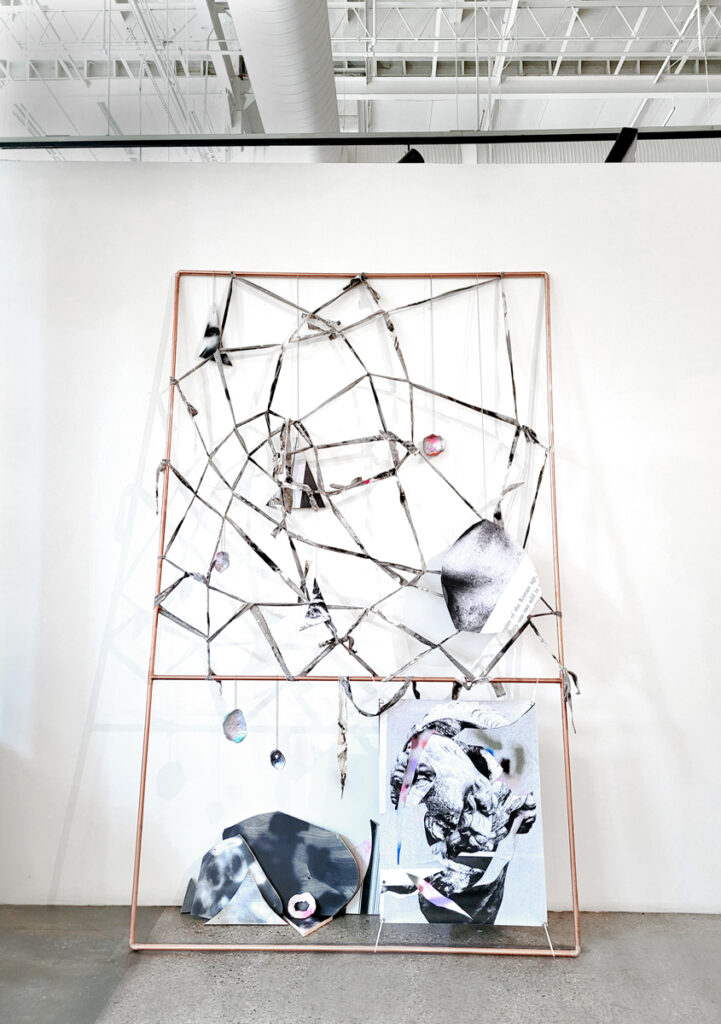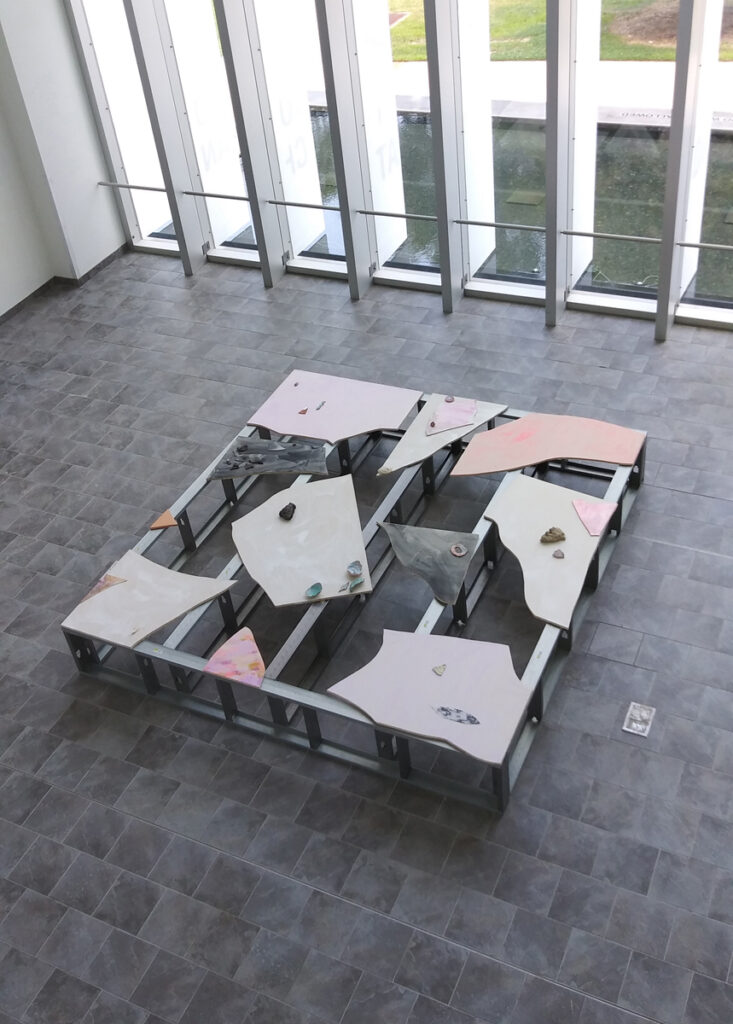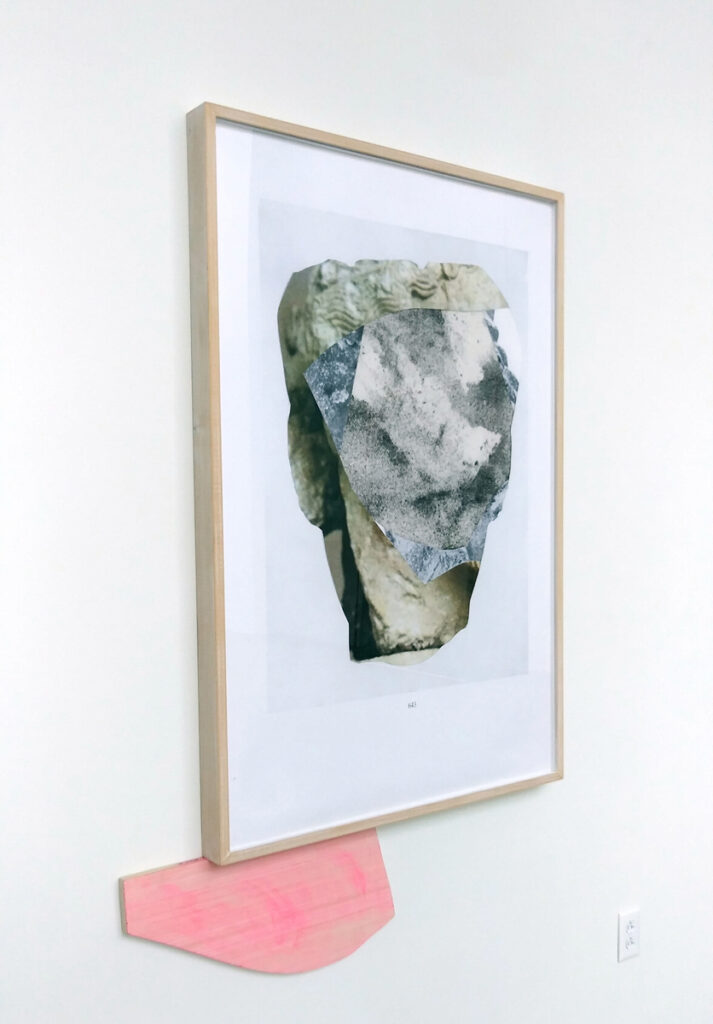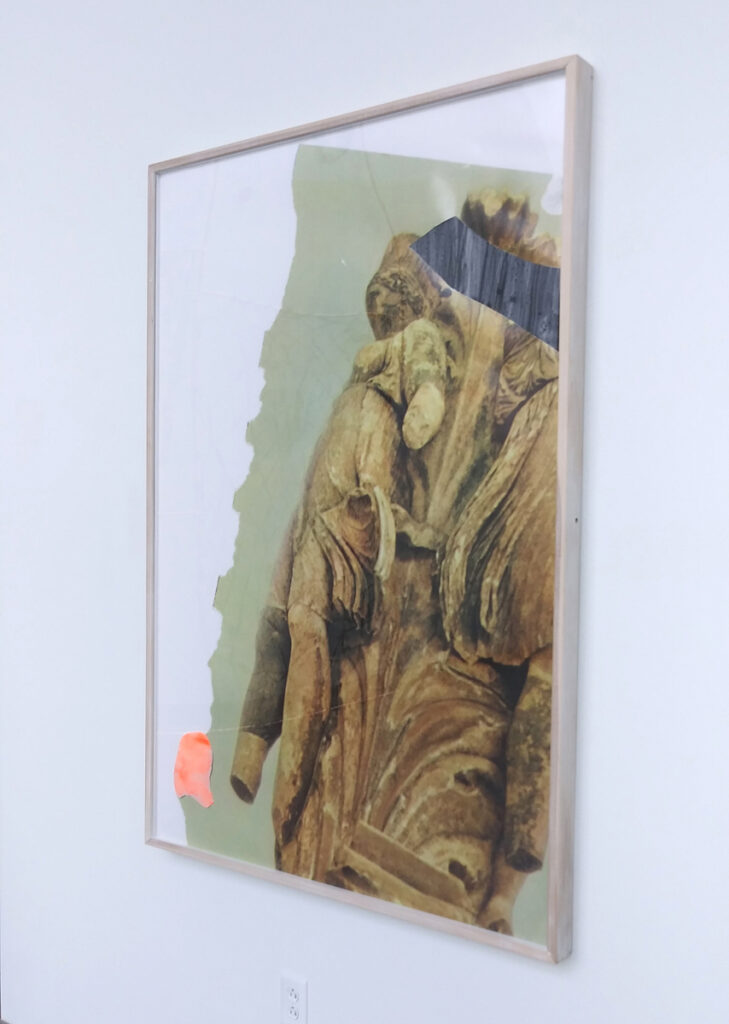In their collaborative work, Lauren Rice and Brian Barr are known for making installations, objects, and image-based works that respond to the physical space in which they’re shown. Straddling the edge between image and object, their large-scale wall-leaning works, photo-based collages, and sculptures draw on our understanding of visual boundaries and their transgression. For more than a decade, the two have combined their individual practices to produce works that respond to and resist our informed readings of images.

Consider, for example, the work Absence Makes (Part I), in which cut-up vinyl prints and spray-painted strips of material have been assembled and stretched over a frame of copper tubing. The printed material, depicting a classical bust, has been cut up and then reassembled. The method of creating a collage mirrors how artifacts are excavated and restored, a fact mirrored by the black-and-white reprographics presenting the image through an archaic medium. This dichotomy of material and image elicits a reaction to how we intuit meaning, how we understand the object referenced by the image, and how we approach this relationship in terms of time and space.

Handmade components often act as a fixed counterpoint to the fragmented image in their work. In Absence Makes (Part 2), for example, the spray-painted strips have expanded in the upper portion, forming a web within which the viewer’s gaze becomes entangled. Also hanging from various points of the frame are discretely placed objects made out of clay, with intermittent flashes of spray-painted color spread throughout. These components lead the viewer’s eye around the work, to discover the fragmented prints on vinyl again at the bottom, as well as resting on the wall behind the frame. Together, these dispersed elements clue in the viewer about how amassed objects compose an image, while also creating a sense of spatial tension by breaking up the two-dimension visual plane.


The frame becomes another device asking us to consider the physicality of Rice and Barr’s constructions as images. The frame offers a sense of containment and a liminal edge to cross over. This is particularly evident in the work Islands (2019), where the work’s flattened-out horizontality invites us to look down at its surface as a tabletop with a clearly defined perimeter. Scattered across its surface are fragments of ceramic objects with subtle hues placed on top of fractured panels that sometimes align with and sometimes defy the border. One can imagine the broken panels moving around modularly until the decision is made for them to rest as a composition. More than anything else, the process seems driven by intuition.
As with much of Barr and Rice’s work, the work’s planar orientation speaks to something else that is notable and familiar in our time—that is the perspective dictated by the screen. Now that we view so much visual material on screens, we’ve become habitually locked into the gaze of the scrolling plane. By addressing the surface and focusing on frontality, their work belies awareness of the screen image’s authority, speaking a shorthand in the lingua franca of today’s media legibility.


At the same time, however, the pair’s frequent disruption of this visual plane defies our sense of certainty about the image’s definition. Where does the image end and the object begin — or vice versa? Here, it seems we are left at another threshold: recognizing how the accumulation of objects constitutes the image versus how the image serves as mere documentation of the physical object. At this liminal juncture, the dichotomy between image and object falls apart, leaving us adrift in an experience of visual non-duality.
Another question can be raised about our senses, which involves the role of aesthetics in Rice and Barr’s work. In contemporary art, aesthetics are often defined in visual formal terms, such as how the work appears to us visually or stylistically. Looking at the root of the word in Greek, however —aisthetikos—we come to understand its meaning as the perception of things through the senses, or even the grasping of things through the mind. In this sense, we would understand aesthetics as involving one’s faculties, or abilities, to sense physical or psychological phenomena.
Given the inadequacy of the photographic image to fully represent the physical experience of being present in front of a work, it might be said that aesthetics can act as a kind of disembodied medium that guide the senses. Not only the physical senses, but the psychological as well, offering access whether the experience be in person or via documentation. Here, aesthetics become a kind of universalizing force, or medium, for viewing and sensing.

While Rice and Barr’s work causes one to reflect on the experiences of viewing and sensing, it also leads us to ponder other issues involving historical perspectives about art and its making. The references to viewing and their sensitivity to media feels squarely contemporary in practice, yet the interpretations involving the senses seem almost pre-modern or classical. Historically, a common approach for interpreting art was by looking for its literal, allegorical, tropological, and anagogical values—respectively corresponding to the work’s physical/historical fact, its symbolism, it’s typological/moral meaning and the universal implication of its narrative. One is compelled to search for similar parallels in their work.
The writing of Art historian David Joselit is also especially apt while considering the role of image and object in their work. For Joselit, our world of cultural products and output has been transformed by results and information gleaned from sources such as Google. In his ‘After Art’ (2013) Joselit frames the issue as one dealing with site and mobility:
One could say…that it is saturation through mass circulation—the status of being everywhere at once rather than belonging to a single place—that now produces value for and through images…Instead of a radiating nimbus of authenticity and authority underwritten by site specificity, we have the value of saturation, of being everywhere at once.
—’After Art’, Joselit. p. 16
Being a visual artist at a moment when our fields of vision are so saturated with images is no easy task, yet Barr and Rice appear to navigate these waters with playfulness and an eye kept on the value of what can be mined from being at the center of viewing and sensing. But the question must then be asked: if the center is defined by the position of the viewer, where does that leave us now, since through the plurality of today’s media, the center now seems to be everywhere? And if the center is everywhere, where does that leave the edge, the border, or the periphery? How do we define spaces or territories?
If indeed the center is now everywhere, it would suggest the periphery is also nowhere. Instead of physical boundaries, territories would be defined by the experience of encounters that occur in an open, non-hierarchical visuospatial and sensual ecosystem. Here, mutual exchange and interplay take place between both intended and unintended agencies that are always at the cusp of being and becoming—in a space where the center and periphery mutually yield and offer up their positions.
—Ian Pedigo
All images, courtesy the artists
Please visit Barr and Rice’s profiles on Art-l.ink for more:
Lauren Rice:
https://art-l.ink/laurendrice/
Brian Barr:
https://art-l.ink/brian-barr/
.


